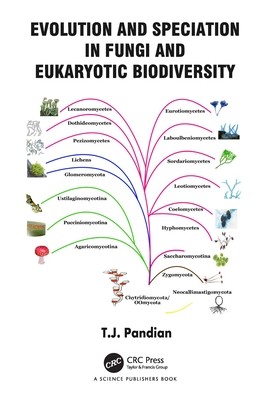
- We will send in 10–14 business days.
- Author: T J Pandian
- Publisher: CRC Press
- ISBN-10: 103242141X
- ISBN-13: 9781032421414
- Format: 15.6 x 23.4 x 1.9 cm, hardcover
- Language: English
- SAVE -10% with code: EXTRA
Evolution and Speciation in Fungi and Eukaryotic Biodiversity (e-book) (used book) | bookbook.eu
Reviews
Description
Being sessiles like autotrophic plants and heterotrophics as animals, fungi are fascinating eukaryotes. In them, the need for external digestion has demanded surface expansion and limited tissues to 20% loss of commercial crops. Despite their ecological and economic importance, no university offers degree course in Mycology. For 2,056,907 eukaryotic species, this book elaborates the role played by environmental factors (i) spatial distribution, (ii) light-temperature, (iii) precipitation-liquid water and biological attributes, (iv) cellularity, (v) symmetry, (vi) clonality, (vii) sexuality, (viii) modality and (ix) motility that either accelerate or decelerate biodiversity. About 20 and 80% eukaryotes are aquatics and terrestrials. Decreasing light intensity and temperature reduce diversity from the equator toward the polar zones. Water availability also reduces the diversity from 5.4 - 65.5 species/km2 in tropical evergreen forests to 200 in mammals reduce clonality from 100 to 0%. Strategies developed by eukaryotes reduce selfing by
EXTRA 10 % discount with code: EXTRA
The promotion ends in 19d.17:44:40
The discount code is valid when purchasing from 10 €. Discounts do not stack.
- Author: T J Pandian
- Publisher: CRC Press
- ISBN-10: 103242141X
- ISBN-13: 9781032421414
- Format: 15.6 x 23.4 x 1.9 cm, hardcover
- Language: English English
Being sessiles like autotrophic plants and heterotrophics as animals, fungi are fascinating eukaryotes. In them, the need for external digestion has demanded surface expansion and limited tissues to 20% loss of commercial crops. Despite their ecological and economic importance, no university offers degree course in Mycology. For 2,056,907 eukaryotic species, this book elaborates the role played by environmental factors (i) spatial distribution, (ii) light-temperature, (iii) precipitation-liquid water and biological attributes, (iv) cellularity, (v) symmetry, (vi) clonality, (vii) sexuality, (viii) modality and (ix) motility that either accelerate or decelerate biodiversity. About 20 and 80% eukaryotes are aquatics and terrestrials. Decreasing light intensity and temperature reduce diversity from the equator toward the polar zones. Water availability also reduces the diversity from 5.4 - 65.5 species/km2 in tropical evergreen forests to 200 in mammals reduce clonality from 100 to 0%. Strategies developed by eukaryotes reduce selfing by


Reviews